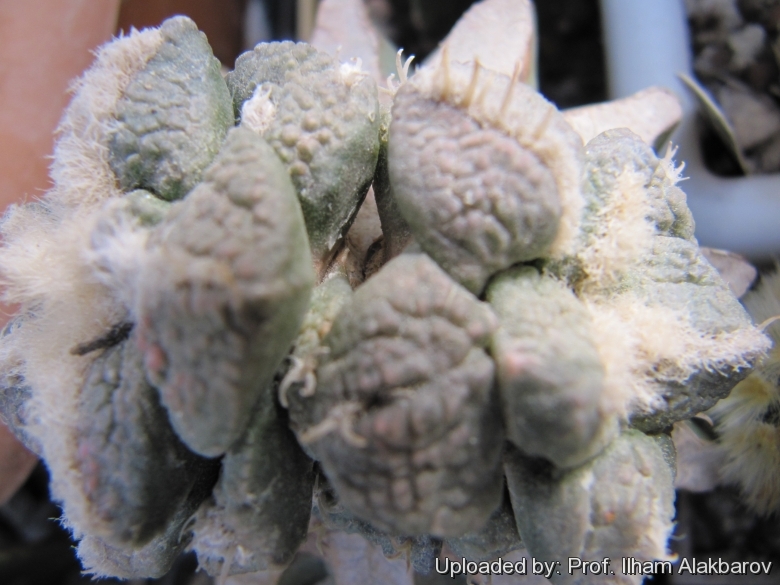Accepted Scientific Name: Ariocarpus fissuratus K.Schum. in Engl. & Prantl
Nat. Pflanzenfam. Nachtr. [Engler & Prantl] 3, Abt. 6a: 195. 1894

Ariocarpus fissuratus f. pectinatus Photo by: Prof. Ilham Alakbarov
Origin and Habitat: Ariocarpus fissuratusSN|2114]]SN|2114]] grows naturally in Southern USA northern Mexico on dry limestone ridges and rocky hills of limestone chip, but the form "pectinatus" has been only described from cultivated specimen.
Synonyms:
See all synonyms of Ariocarpus fissuratus
back
Accepted name in llifle Database:Ariocarpus fissuratus K.Schum. in Engl. & PrantlNat. Pflanzenfam. Nachtr. [Engler & Prantl] 3, Abt. 6a: 195. 1894Synonymy: 22
Cultivars
(8):
back
Description: Ariocarpus fissuratusSN|2079]]SN|2114]] f. pectinatus is an odd very rare plant distinguished by long adiaxal areoles that stretch out to the full length of the tubercle and uncommon short pectinated spines. This plant differs from the standard Ariocarpus fissuratusSN|2114]]SN|2114]], for its short pectinated spines already present in young specimens. The spines persist with the age, but in adult plant they are partially covered by fur.
Similar species:  ]SN|2079]] subs. pectinatus] Weisbarth shows similar pectinated spines, and is much more common in cultivation.
]SN|2079]] subs. pectinatus] Weisbarth shows similar pectinated spines, and is much more common in cultivation.
Habit: It is a geophyte plant that produces a star-shaped rosette of fleshy, deltoid to hemispheric tubercles, which have no spines and lie almost flat on the soil surface. They are usually solitary, rarely giving rise to side shoots from old areoles, they grow extremely slowly, to 20 cm in diameter.
Tubercles: The tubercles, about as long as wide, are closely packed and form a coarse mosaic. Exposed faces of tubercles, deeply fissured on either side of the central areolar groove, are coarsely rugose, and are often sharply angled apically; and with a lateral longitudinal furrow on each side of the tubercle, along the edge.
Areoles: The areoles are up to 3 mm wide, linear, stretching out to the full length of the tubercle.
Spines: Short, arranged like the teeth of a comb on the full length of the linear areola, about 2-5 (or more) mm long.
Roots: Each plant has a large turnip-like taproot, which lies below the soil surface and serves for water storage.
Flowers: These plants have a woolly crown, from which emerge bright pink-violet flowers up to 2,5-5 cm, 2 times wider than long when fully expanded. Flowers last for 3 to 4 days.
Blooming season: October, November.
Fruits: white or green, with lots of seed.
Subspecies, varieties, forms and cultivars of plants belonging to the Ariocarpus fissuratus group
Cultivation and Propagation: Ariocarpus fissuratusSN|2114]]SN|2114]] is not too difficult in a greenhouse, although it grows extremely slowly (it starts blooming at the age of 8-12 years).
Soil: Use a loose mineral cactus mix with extra perlite or pumice and clay pots help the plants to dry out between watering.
Repotting: The plants need deep pots to accommodate the napiform unit formed by the stem base and the rootstock (or they will often simply crack your pots). Generally, they should be repotted frequently at least every other year in order to provide fresh soil. However, old plants become senile and have a tendency to succumb to disease and a weak root system. At this stage, as is well known, they die suddenly. So, after they reach 20 cm in diameter grow them slowly, and adopt a new repotting period, using intervals of every 3 years. Additionally grow them under drier conditions or with stronger sunlight. However, repotting doesn't necessarily mean they'll need larger containers.
Sun Exposure: Partial sun or light shade. They need a good amount of light, a place near the roof of the greenhouse helps drying the pot after watering.
Watering: They require moderately watering through the growing season. This can be done weekly during the summertime, if the weather is sunny enough, with a little fertilizer added. Kept this way, plants will show a healthy, although slow growth. Keep dry as soon as the temperature starts dropping in October and keep it perfectly dry in winter at temperatures from 5 to 15 degrees centigrade.
Hardiness: Winter care presents no problems at 5°C with plenty of light., but frost hardy to -10°C.
Pest and diseases: They are generally fairly easy to grow, especially if kept pest-free. They are susceptible to stem and root mealy bugs, and damage from these may well initiate fungal attack.
Propagation: By seeds, remembering that seedlings dislike strong light and dry conditions, but the grafted plants are typically rather tall- growing, compared with plants on their own roots, that are usually flatter to the ground.











